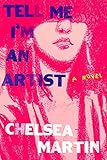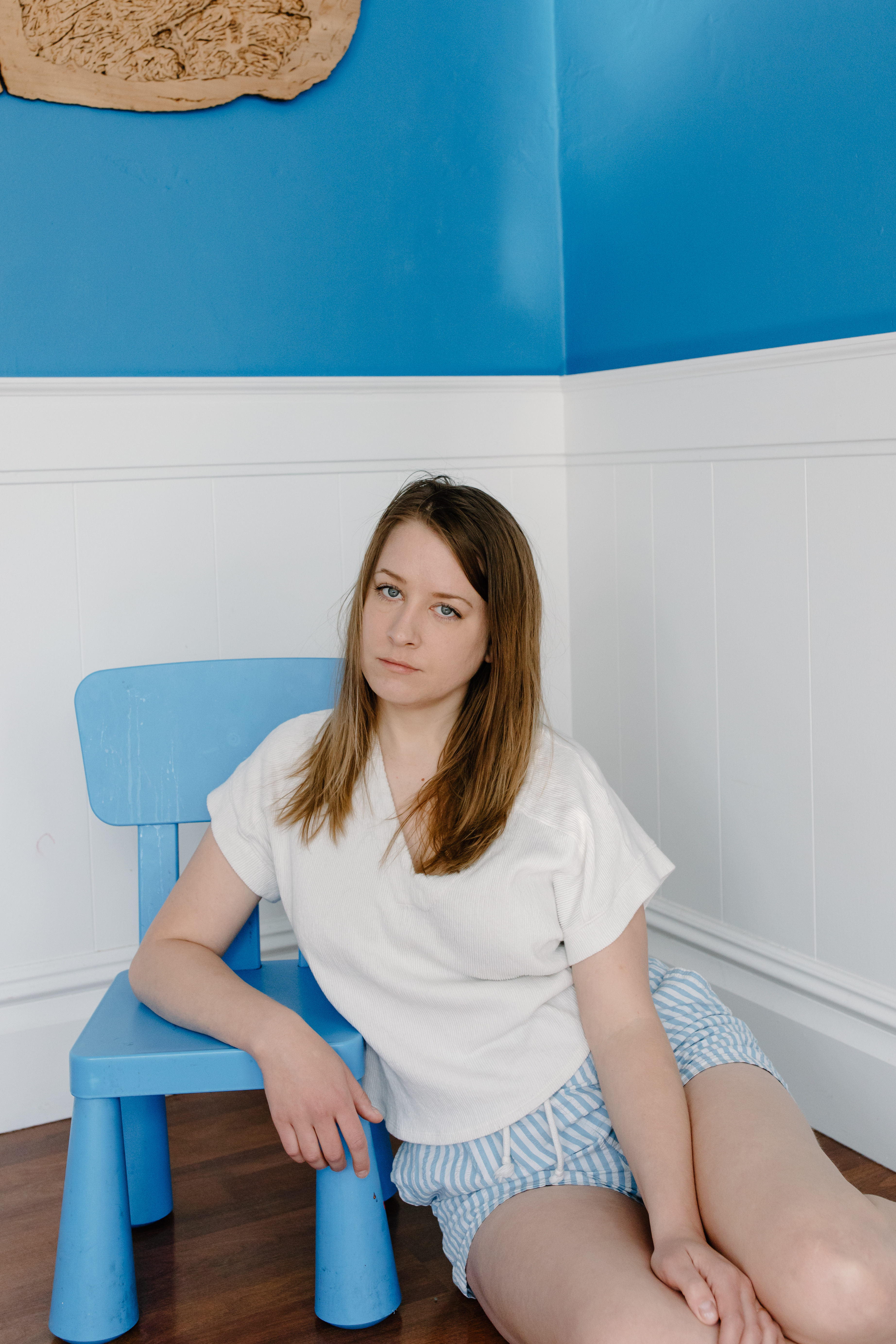When I was in high school, I fantasized about the kind of artistic life I would have in college, one where I would master my craft and then truly show the world what a genius I was, even though, at that point, I didn’t even have craft to call my own. Then, in college, I took an Art 101 class. This is it, I thought. What I was always meant for. But I never seriously pursued art—instead, I majored in journalism and graduated just in time for the collapse of the newspaper sector. I never became a journalist. Shortly after, I discovered the work of Chelsea Martin via her book Caca Dolce, a collection of essays about coming of age as an artist amid financial obstacles, among many others. It was, to say the least, relatable.
 So I was thrilled to dig into Martin’s latest novel Tell Me I’m an Artist, which follows a young art student named Joey as she struggles to complete a self-portraiture project. Martin’s penchant for satire and dark humor, plus her profound counter, continue to amaze me. I spoke with Martin about writing comedically, the discomfort of nonfiction, and letting your work speak for itself.
So I was thrilled to dig into Martin’s latest novel Tell Me I’m an Artist, which follows a young art student named Joey as she struggles to complete a self-portraiture project. Martin’s penchant for satire and dark humor, plus her profound counter, continue to amaze me. I spoke with Martin about writing comedically, the discomfort of nonfiction, and letting your work speak for itself.
Elle Nash: The narrator of Tell Me I’m an Artist, Joey, deals intensely with imposter syndrome, with not feeling good enough. What happens when you begin to feel this way while also making art? How do you go on? How do you surmount the insurmountable?
Chelsea Martin: I only feel imposter syndrome when I’m asked questions about my art. I feel like I don’t have concrete ideas or decision-making processes about what I’m doing in the ways that people expect, and if I don’t have good or satisfying explanations about what I’m doing or why, it makes me feel like I’m not qualified to be a writer. But a lot of the time I don’t consciously know what I’m doing, and until someone wants an answer about what I’m doing, I honestly don’t see a problem with that. I don’t need that kind of clarity. So I try to remember, when I feel like I don’t know what I’m doing, that there are many ways to experience art, and if what I say about my own art matters to some people then that’s their problem. When I’m actually writing, I don’t feel accountable to anyone other than myself. Even if I’m struggling, it doesn’t feel like I’m pretending or fooling anyone—I just haven’t yet solved the problems I gave myself.
 EN: What was it like working on this novel in comparison, to your novella Mickey, or with your nonfiction book Caca Dolce? What have you learned about yourself and about writing through this process?
EN: What was it like working on this novel in comparison, to your novella Mickey, or with your nonfiction book Caca Dolce? What have you learned about yourself and about writing through this process?
CM: Mickey and Caca Dolce were both intense, focused projects that I had finished drafts for in about a year. Tell Me I’m An Artist took me way longer to write than anything else I’ve ever written. I went through some major life changes while writing and editing it, like buying a house, getting married, being pregnant, being a new mom, not to mention the collective traumas we’ve all been through in the last couple years. I took lots of long breaks from writing. But it was sort of the perfect project to work on during all of this, because I struggled so much with the idea of writing my little novel while so many more important things were happening. It was very healing to create a character dealing with similar problems, and to persevere despite it feeling very stupid.
EN: Now that you’ve got several books under your belt, do you believe that every book a writer completes changes them as a person?
CM: Sure, though I’m only speaking for myself. I think that it is more true with each book I write. I accomplish a lot of self-work through writing. Working within a set of themes and topics over months and years is a great opportunity to learn about myself and process things.
EN: How do you approach writing fiction and nonfiction differently, especially in terms of storytelling? I used to only be able to write essays, for example, because I had a background in journalism. But now I’ve been writing fiction for so long, the idea of writing an essay makes me freeze up. Something about it now feels so limiting, so hard. Maybe this is similar to Joey’s struggle in re-creating the movie Rushmore as part of her art project. It’s easier to set a story outside of me and say it’s not about me. But an essay is more often like a self-portrait. Is it hard to switch between the two modes?
CM: Right now I see more of a hard line between short-form and long-form writing, rather than between fiction and nonfiction. After writing a novel, the idea of trying to write something short that doesn’t have all the layers and complexity and time with a character seems so limiting. But I do think that making art with the idea of “this is about me” can be really intimidating. What is it that I want to say about myself, and why do I want other people to know? Why am I advertising this thing about myself, and what if I change, or what if making this solidifies this fact about myself and I can’t change, or what if I’m misunderstanding myself completely? Admittedly, I find the promotional aspects of nonfiction more difficult than the actual writing. After my essay collection Caca Dolce came out and I was doing interviews about my own ideas of myself or how other people interpreted my experiences, I was like, I’m never writing this literally about myself ever again. Or if I do, I’m not taking any questions. Too fucking uncomfortable.
EN: Joey has class struggles. Can you talk to me about your working life as both an artist, mom, and person-who-has-to-make-money-to-live? How do you balance all of the things you want to do, as an artist and author, with all of the things you have to do to live day to day?
CM: Oh, god. I don’t think I balance anything very well. It feels like I use half my brain power just organizing my time and making sure I have my priorities straight. And my priorities are still wonky as hell. The past few weeks, most of my spare mental energy has been spent trying to adapt a birthday cake recipe for my son’s medical keto diet. Meanwhile our savings are rapidly slipping away. I’m completely freelance, and it seems like finding work is the first thing that drops off my to-do list when things get busy. I have this weird faith that opportunities for making money will come to me when I need them. But I do not know what I’m doing and no one should follow my example.
EN: Why do you think that it’s easy for young artists to fall for certain tropes, dreams, or ideas about what artists do and how they live? What do you think it really means to be an artist?
CM: Being an artist is a process of discovering myself. What a gross thing to say. It takes a lot of work to come up with an idea that I want to think about for a long time. So that alone requires a level of self-understanding I haven’t always had. But even once I have an idea, I’m always surprised by the issues or feelings or personalities that surface. There is always some underlying trauma that I wasn’t expecting that gets exposed while I’m writing a book. Is this what young artists think writing is? I don’t really know. As a young writer and artist, I think I brought less of myself to the page, wanting writing to be quick and fun and raw, and now I realize it is a long, demented self-analysis to determine what is worth thinking about and working on for years.
EN: The narrative of Tell Me I’m An Artist captures the feelings of anxiety that come with wanting to be great. It dramatizes the back and forth a person goes through in the throes of wanting to believe in themselves and their abilities, especially when faced with people around them that might not believe in them. Can you talk a little bit about how you’ve developed your narrative voice over the years?
CM: Elle, I just googled what “narrative voice” was. If I’m a master of anything it’s avoiding thinking about “craft.” But now that I’ve googled it I will say this: I want my writing to feel very intimate, like the unreliable, fickle narrator inside your own head. As a young art maker, I think there is always that back and forth, that wanting to believe you are special coming up against the deep belief that you are not, and trying to find the answers in other people who have their own set of problems and aren’t really that concerned with you. I approached Tell Me I’m an Artist as if it were a diary. I wanted to include those great moments of Joey’s total self-confidence as well as the very low points, and of getting sidetracked and amusing herself and despairing and fantasizing about what might happen if she does or doesn’t succeed, because that tumultuous process is part of what makes the life of an artist interesting to me.
EN: You have a skill that I think many writers struggle with: comedy. I struggle with it. I feel like I’m funny in real life but could never be funny in my fiction. Something about the process of writing humor within the context of fiction is very daunting. How do you know when something you’ve written hits the right way or is going to make someone laugh?
CM: I actually tried to be less funny with Tell Me I’m an Artist! I think humor can be really cringe in writing, and often, for me, it’s a way to avoid saying something difficult, or to distract the reader from an unfinished thought. But I have to entertain myself, otherwise I simply will not write, so humor is always going to be in my work. Mostly I think the trick is to do what makes you laugh and not worry what is going to “hit.” But another thing I’ve learned to make my humor less cringe is to make the funny thing surprising and layered rather than just a punchline, that way it is doing something to propel the story forward even if the reader doesn’t find it funny.
EN: If there was one thing you could go back and tell your younger self about making art and writing, what would it be?
CM: I don’t think she’d ask me for advice or listen to me if I gave it, but I think I’d probably try to convince her to take literature classes instead of three years of weaving in art school. Nothing against weaving but I’ve never had the space for a loom, so my vast textile knowledge goes unutilized.










